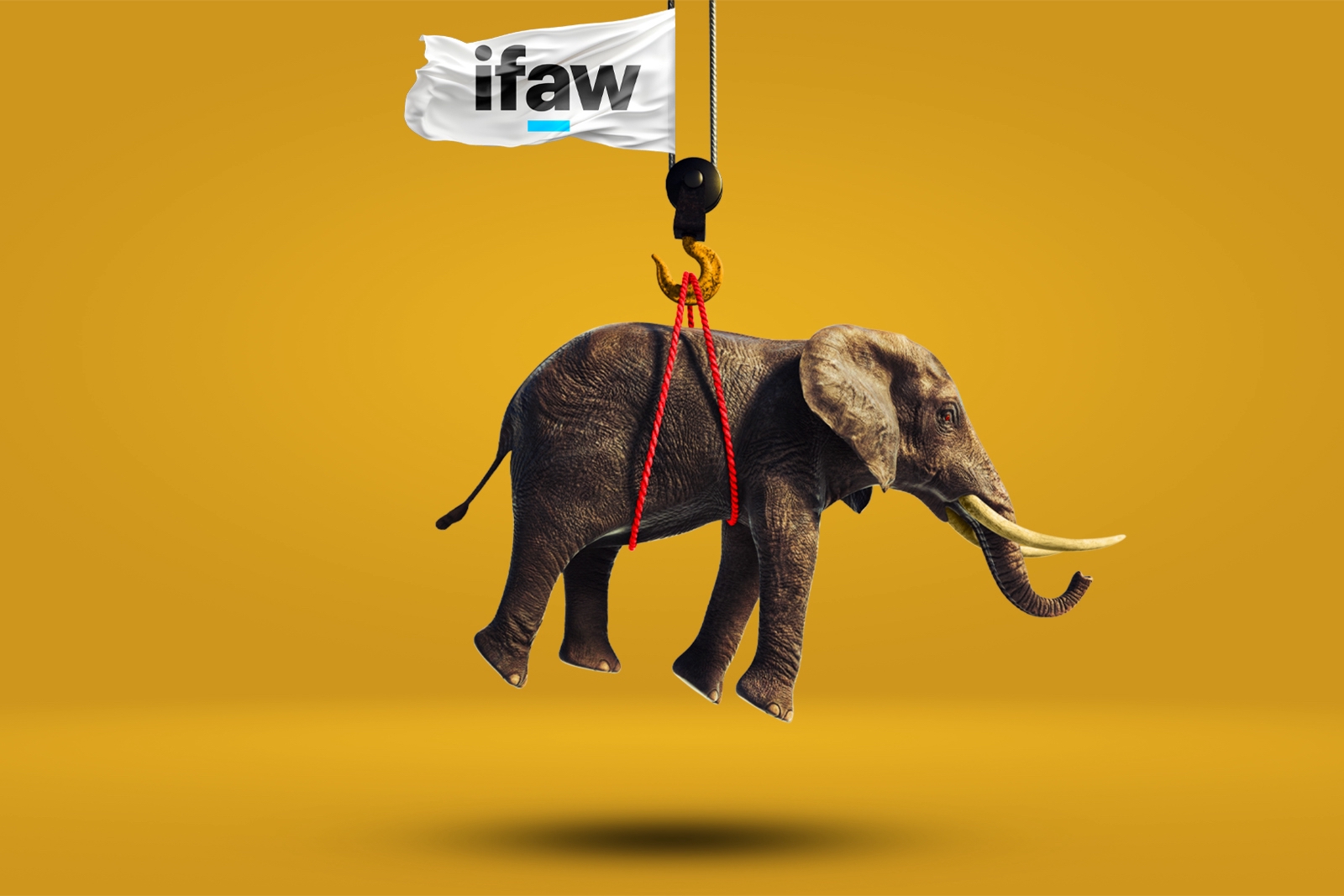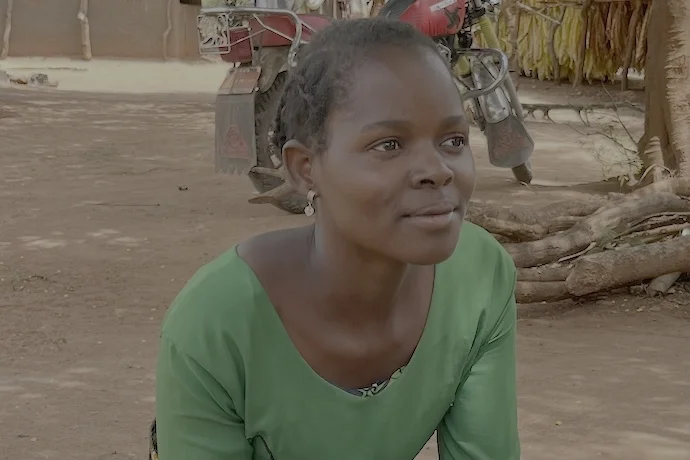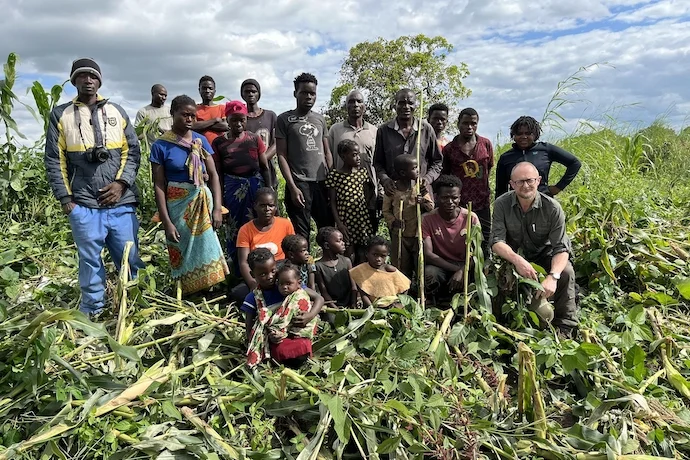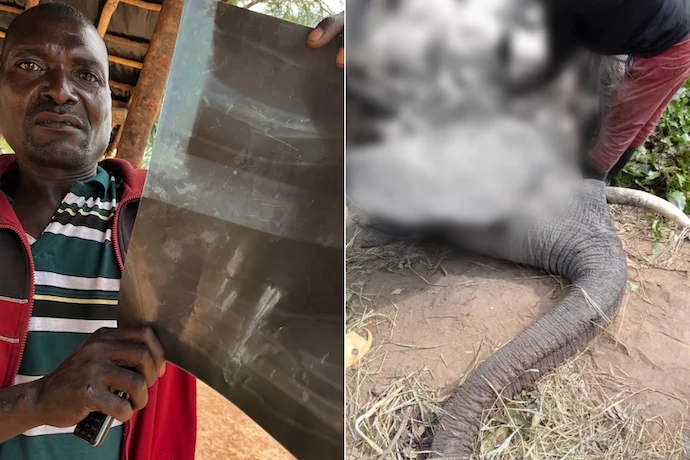
In Rural Malawi, a Western NGO Imported Elephants. Chaos Ensued.
Few people have heard of Kasungu National Park in Malawi. The 2,000-square-kilometer park is located on the border with neighboring Zambia. Now, the park has become the center of a bloody man-made conflict between humans and elephants, resulting in extensive suffering among both humans and elephants.
Elphina Joseph (23) and her three-year-old son Success have traveled more than 170 km on the back of a motorcycle through the scorching hot Malawian bush to meet me near the Zambian border and tell the story of Elphina’s husband Joseph Kampamula, who was killed by an elephant coming out of Kasungu National Park on July 12, 2022. 26-year-old Joseph was utterly unprepared when the elephants attacked him and injured him so severely that he died from his injuries before he could reach a hospital.
The accident happened far from the park, and Elphina, who was pregnant with their son, lost both the love of her life and the primary breadwinner of her family. Since then, no one has offered her any help, and she now supports herself and her son as a farm worker in Malawi. There is barely enough money to buy food, let alone the simple school supplies needed to go to school in Malawi. The future looks anything but bright for the struggling little family. Yet, Elphina manages to keep her composure as she shares her tragic story. I see the sadness in her eyes, and I hear it in her voice, but I also sense that she is driven first and foremost by a burning desire to achieve justice for her late husband, herself, and their young son, who climbs all over his mother during our conversation.
Justice plays a role because Joseph’s death was not an unforeseeable or unavoidable accident.
The elephant that killed him had been relocated from Liwonde National Park in southern Malawi a few days earlier and then released in the nearby Kasungu National Park. The project was one of the largest elephant translocations in recent history. Western animal rights organization IFAW presented it as a key part of their “Roam to Roam” plan to open the African landscape to herds of wandering elephants. However, IFAW, working with African Parks and the Malawi Parks Authority to relocate the elephants, had ignored all warnings about the high likelihood of dangerous conflicts with locals. Nor had they prepared the area for the massive release or consulted with local farmers outside the park. They didn’t even warn them, for that matter.

Good in theory. Bloody in reality
In stark contrast to the plight of Elphina, IFAW raises vast sums of money yearly in Western countries. The business model is simple. It runs large-scale campaigns targeting kind-hearted people and encourages them to donate money to help animals in need. Few people can resist a picture of a shivering baby elephant. When you are told that your contribution can help “save” elephants from extinction, you are not far away from donating a few dollars and falling asleep smiling, having done something good for the animals. But there is no accountability, no public demand for proof that the elephants are actually saved in a sustainable manner, and the business model rests heavily on a false narrative.
Elephants in southern Africa are not endangered. They don’t need saving. The population is hundreds of thousands and has been growing steadily for decades. The lands that can accommodate elephant populations are, in most places, overcrowded, and the large populations of increasingly hungry elephants are increasingly resulting in violent conflicts with the poor local population. So when IFAW decided to move elephants from Liwonde, which had a huge population, to Kasungu, which had a much smaller population and limited natural capacity, it was in no way necessary to protect the elephant as a species.
But it was undeniably a flashy prestige project that was an ideal basis for future fundraising. Here, IFAW could demonstrate that, as an organization, they were good to the elephants, which Western donors loved more than any other African animal. On this basis, the organization chose to implement the project despite all the red flags. IFAW knew the elephants would leave the unfenced park relatively quickly and cause problems on neighboring farmland. Still, the prospect of large donations after the large-scale “rescue operation” trumped any consideration for the local communities.
Now, almost three years after the relocation of elephants to Kasungu, the situation looks extremely bleak.
So far, 12 people have been killed, at least as many have been injured, thousands of children are prevented from attending school, and an estimated 12,000 destitute people across 167 villages have lost much of their meager income due to extensive field damage for several years in a row.
The staggering number of people affected by elephant damage is based on data collected by Warm Heart Initiative – a local NGO founded to monitor the consequences of IFAWs elephant translocation. Local volunteers in both Zambia and Malawi inspect and record every damage brought to their attention. In every case, they record the name and contact details of the principal of each affected family. So far, the list numbers more than 1,600 names – and with an average household size of a little more than seven people, the total number on record is now above 12,000. According to Warm Heart Initiative, this is, however, only the tip of the iceberg, as many of the locals are afraid of contacting the NGO out of fear of reprisals.
These are all direct results of the failed relocation of 263 elephants in 2022. The project – one of the most significant elephant relocations ever – tripled the number of elephants in Kasungu. IFAW was warned against relocating such a large number of elephants without preparing the park with the necessary infrastructure and consulting with the surrounding local population. Still, the organization chose to ignore the many warnings. In the wake of the many problems, IFAW disclaims responsibility and points to the Malawian authorities as solely responsible. A spokesperson for the organization told The Guardian that “IFAW (merely) provided technical and financial support for the relocation in accordance with best practice in the field.”
In reality, IFAW presented the project to potential donors as their own at the time. They did the scientific groundwork and raised most of the funds needed for the relocation themselves. They drew up the plans for the project and are still very active in managing Kasungu. Without IFAW and its “Room to Roam” project, the elephants would never have been relocated.
Within 24 hours of moving the first four elephants, they had killed two local farmers who, unaware of the massive elephant relocation, had encountered the large animals on their farms. But not even this incident caused IFAW to reconsider the project, and the rest of the elephants were relocated with much media attention.

A landscape of fear
In March, I spent four days in the Zambian farmland on the western side of Kasungu National Park in Malawi. It was the end of the rainy season, and the landscape was green and lush. We drove more than 900 km in four-wheel drive vehicles and on motorcycles on dirt roads in such disrepair that ordinary cars would stand little chance of traveling on them.
We stopped 21 times to interview some of the many victims of the human-elephant conflict that has ravaged the area for the third consecutive year. In total, I met more than 200 people. Children, young people, adults, and elderly people struggle to survive as small-scale farmers. They grow corn, soybeans, sunflowers, and tobacco on farms that often cover only two to ten hectares and are typically cultivated entirely by hand.
During one of the many stops on the tour, I met farmer Abuld Mumba (56) in his fields in Kasindila. He is the head of a family of 32 people who live off the yield of a few hectares of farmland, which they all – young and old – cultivate together with hoes and spades.
A large herd of elephants had made an unwanted visit the night before. After a long night of trying to scare the elephants away from the nearly ripe crops, the villagers were tired. They were disheartened that they had failed to drive the large animals out with loud drumming on empty buckets and pots – the only means they had to defend their livelihood. They told me that they live in a state of perpetual fear and lack of sleep. The elephants in the area have long since become accustomed to noisy farmers and their families, and the result is evident in the trampled fields. There is nothing left to harvest. Nothing at all. The elephants have destroyed it all, and this is the third year in a row that the elephants from Kasungu have destroyed a large part of the crops on the farm.
The severity of crop damage in these fields in a poor corner of Africa completely differs from the consequences of wildlife damage to fields in Europe. In Africa, even relatively limited damage is a devastating loss of food and income. The consequences can easily be hunger and a lack of schooling for children – because the cost of school is too much when families don’t have money to buy food. The communities can’t afford failed years here—let alone consecutive ones.
Farmers have no legal means to defend themselves or their crops with firearms. Deliberately hurting or killing an elephant costs five years in prison in Zambia and 20 years in Malawi. That’s roughly in line with the punishment for murdering your neighbor. In Europe, farmers can control wildlife pests themselves, earn income from hunting, and no one has to fear hunger or being unable to pay for their children’s schooling.

Is an African life worthless?
Abuld is both furious and desperate. The family has farmed this land since the 1970s, and no one had seen an elephant in the area until the animals suddenly appeared in large numbers in 2022.
“Would people in Europe put up with IFAW releasing 263 elephants into their neighborhood without asking them?” he asked rhetorically. I told him many Europeans would not tolerate sharing their land with far more peaceful species, such as wild boars or wolves.
The family – and countless other families in the area – have appealed to the authorities and IFAW for help. Help in the form of an electrified fence to keep the elephants inside the national park, supplemented by an adequate contingency of rangers to drive them back when they break out. Of course, they also demand sufficient compensation for the damage the animals cause on farmland. But they have not been heard. On the contrary, IFAW is actively trying to cover up the issue.
They deny the problems, ignore all requests for assistance, and disclaim any responsibility. The same goes for authorities in both Zambia and Malawi.
During our tour, some of the farmers informed us that IFAW staff were driving around the same area and asking about what kind of “Mzungu” (white man) was interviewing the locals. The situation in the region is tense, and to avoid unwanted clashes with IFAW staff—who have no formal authority outside the national park—we moved quickly between villages in a somewhat random pattern, staying only 15-20 minutes at each place we stopped.
I spoke to at least 20 different families. Their message was the same everywhere. No one wants to share their crops with elephants from Kasungu. No one wants to live in perpetual fear of being attacked in the fields by elephants or the animals breaking into their stores in the dry season. More importantly, no one has been offered the slightest help – either practical or financial – to deal with the situation.
The elephants are suffering, too…
As for the elephants, you might hope that the relocated elephants would at least thrive in their new habitat. Unfortunately, this is far from the case.
As a (reasonably expected) reaction to the extensive damage, the affected rural population has started to take matters into their own hands. So far, over 40 of the relocated elephants have been killed with poison and homemade firearms – despite the risk of long prison sentences. Another 40 or so of the large animals have left the area and gone deep into neighboring Zambia. The elephants are exceptionally stressed and, in several cases, have abandoned dying baby elephants in villages outside the park.
Shira Zilase Phiri (38) has twice had elephants visit her farm. On one occasion, the animals destroyed the family’s house to get to their supply of maize; on the other, a sick and weakened elephant lay down a few meters from the house, at significant risk to the residents. She tells us in no uncertain terms how the desperation of the people results in thoughts of vigilante justice: “People in the area have started getting ideas to kill the elephants one by one because we are so tired. We have begged for help from various authorities, but no one has come to our rescue. So now we’re starting to think it’s probably better to start poisoning them. You can ask anyone in Chipangali – no one cares about the elephants.”
The only winner in this tragic case seems to be IFAW, which has raised a lot of money in Western countries and presents this to its donors as a great success story. In 2023, IFAW raised more than $120 million.
A lawsuit is on the way
Is the tide turning for IFAW? An article in The Guardian on March 26 revealed that a group of affected people in Zambia and Malawi are now filing a class action lawsuit in the UK against the organization, demanding compensation for those affected and securing the park against future outbreaks of elephants into the surrounding farmland.
The English firm Leigh Day is representing the plaintiffs in the case. They expect the number of people behind the lawsuit to multiply in the coming months. The plaintiffs estimate that the material damage caused by the elephants amounts to over $4 million, in addition to compensation for families who the elephants have physically attacked.
IFAW President Azzedine Downs introduces himself on LinkedIn as a “champion of communities living with wildlife.” None of the many locals I have interviewed around Kasungu National Park appreciate what IFAW has done to their community. On the contrary, they are now taking the organization to court, and there is probably more to come.
The Warm Heart Initiative, an organization created to help local people affected by the burning conflict, is currently investigating the possibility of going a step further and getting U.S. authorities to indict IFAW leaders. The Warm Heart Initiative believes that IFAW is guilty of negligence in Zambia and Malawi by forcing the elephant relocation that IFAW was strongly warned against and could have stopped after the first tragic deaths. Only time will tell if justice will be served.
Right now, things are looking bleak for both elephants and locals. If the conflict continues—and it will if funds are not invested very quickly to keep the elephants out of the locals’ fields—then the elephants will most likely disappear from the area. If that happens, the entire project will have caused nothing but suffering and death for people and elephants and, of course, enormous revenues for the animal rights organization IFAW.
I reached out to Lindsey Raczka – in charge of U.S. donor relations for IFAW for comment and was told that she had forwarded my request to IFAW’s legal team, who are “actively involved in this matter.” They chose not to comment.
